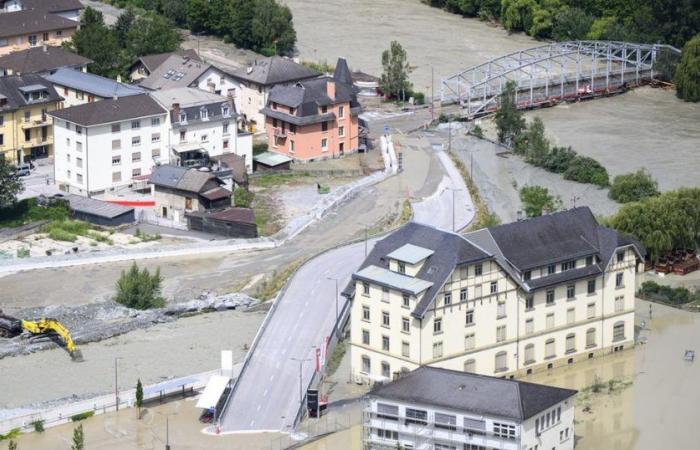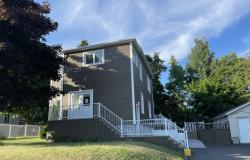Valais and Chablais vaudois have been hit by historic floods, described as the “flood of the century” for the Rhône, surpassing the levels of 2000. An exceptional situation which has fuelled the debate around the third correction of the Rhône, while the canton has decided to review the project.
State Councilor Franz Ruppen (UDC), head of the Department of Mobility, Territory and the Environment, announced at the end of May the revision of the third correction project of the Rhône. According to an analysis launched in 2022, the current project is “disproportionate”. The idea is in particular to minimize the impact on agricultural land by limiting the widening of the watercourse.
>> Event tracking: Alarm raised in Valais after bad weather, but vigilance remains essential
On Monday, Walliser Bote judged that questioning the third correction of the Rhône was a very bad idea. Franz Ruppen declared again last week that the problems mainly came from the tributaries of the Rhône and not from the river itself. This weekend of flooding proved him wrong. Any reassessment of the third correction would cause considerable delays and jeopardize the urgently needed security measures, concludes the editorialist of the Valais newspaper.
The Council of State remains firm
Despite the events of the weekend, the Valais government has remained firm in its position. Frédéric Favre (PLR) assured Forum on Sunday that the events did not call into question the canton’s new objective, which wants to “get to the essentials” and not sacrifice security. According to him, the State Council has chosen a “global approach” that also takes into account lateral waterways.
>> Listen to Frédéric Favre’s reaction in Forum Sunday:
Invited Monday evening to Forum, the current president of the Valais government Franz Ruppen (UDC) said nothing else. For him, the project of the 3rd correction of the Rhone is not abandoned at all and will make it possible to respond to future floods of the river. [lire encadré].
The floods in Valais are due to a “cocktail of several phenomena”, namely late snow that melts very quickly, as well as land saturated with water for months, explained Raphaël Mayoraz, head of Natural Hazards for the State of Valais, on the 19h30 news on Sunday. This ultimately causes a funnel effect, in a steep terrain, with streams that quickly swell the Rhône, causing it to overflow far downstream, as far as Martigny.
But like the Council of State, Raphaël Mayoraz believes that these floods do not call into question the decision of the Valais authorities to rethink the third correction of the waters of the Rhone. The new project, he assures, does indeed take into account the new climatic conditions.
Unfortunately false arguments
For Jean-Pierre Jordan, hydrologist and expert in watercourse development, the arguments put forward by the Canton to review the third correction project of the Rhône are however not admissible. “They are false. They are unfortunately false. And the flood that we observed on Sunday demonstrates, if need be, that some of its arguments are unfounded,” he judged Monday in La Matinale.
>> Listen to the interview with Jean-Pierre Jordan in La Matinale:
The limits of containment
In Sunday’s 7:30 p.m., Jean-Pierre Jordan also explained that the river dikes, which have overflowed in several places, also have their downside.
“We have a Rhone that is a little suspended in the plain, with dike heights that can reach three to four meters. And when the Rhone evacuates the flows at full bank, we have water heights compared to the plain that are very significant.” With therefore an equally high risk of impacts in the event of overflow.
“This is why among the solutions that are recommended, but which are contested, there would be the fact of widening and giving more space to the Rhone in order to lower these water lines”, explains the hydrologist.
>> Review the explanations from 7:30 p.m.:
“Emergency” in Chablais Vaudois
For his part, the Vaud State Councillor in charge of the case, Vassilis Venizelos, recalled in La Matinale de la RTS that we are talking about the “river project of the century” which is based on “20 years of studies by expert offices”, but also “validation by the Valais and Vaud governments in 2016”.
For the Green State Councilor at the head of the Department of Security and the Environment, “there is an urgent need to deploy certain measures (…), particularly in Chablais”, where the industrial zone of Aigle (VD) had to be evacuated as a precaution. “We want the public inquiry to be able to take place at the end of the year so that the work can begin as quickly as possible”, indicates Vassilis Venizelos.
“It is the responsibility of the authorities to prevent and anticipate these risks. This means significant investments, significant costs, but the costs of inaction are much greater,” the Green Party representative also argues.
As a reminder, the cantons of Vaud and Valais had agreed to coordinate in the third correction of the Rhône project. But the revision announced at the end of May by the Valais authorities reshuffled the cards.
Interview by Valérie Hauert
TV topic: Olivier Dessibourg
Adaptation web: Caryl Bussy/vic/rad






